One of the sharpest observers knew to expect the expected. But that did not mean the gathering was an empty talkfest.
“It is completely groomed,” he said in a brief moment outside the Great Hall. “I wouldn’t be surprised if all the breakthroughs and big announcements were written a month ago.”
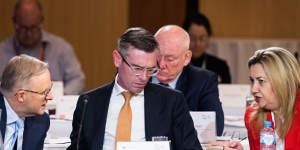
Anthony Albanese,NSW Premier Dominic Perrottet and Queensland Premier Annastatica Palaszczuk discuss policy ideas during the jobs summit.James Brickwood
Yes,it was choreographed. As well,however,it was effective. Even those who could see the tight political management of the event could also engage in talks on the sidelines with people they might never otherwise meet.
Albanese used the moment to call people over for private conversations that included leaders from unions,companies,industry groups and community organisations. The talks were blunt,say some of those in the huddles,but nobody can be sure if they will shape a genuine reform agenda for Labor now it has passed its first 100 days in power.
The immediate outcomes were significant. The government will lift the permanent migration intake from 160,000 to 195,000 this year – slightly less than company chiefs wanted but more than the unions would have accepted a few weeks ago. It will spend more money on the visa system to fix backlogs. It will bring forward 180,000 fee-free places at TAFE colleges in a $1.1 billion deal with the states.
Big issues are also up for discussion. Workplace Minister Tony Burke issued a list of changes to the Fair Work Act he wants to introduce to Parliament before the end of the year but he left room to move when negotiations start between employers and unions next week. Treasurer Jim Chalmers told people he would love to do more on childcare and paid parental leave but has to watch the impact on the October 25 budget,which means the conversation is already starting on what he could do next year.
The lasting impact is a mystery. Treasury already has a team in place to deliver an employment white paper within 12 months.
So the summit is only the start of a discussion about poor wage growth,chronic labour shortages,the underfunding of skills training and the calls for more foreign workers. The ground is being prepared for reforms in Parliament in 2024 and a second-term agenda for the 2025 election.
The tone of the summit was also important. There were slightly more women than men among the official delegates. Some of the most prominent speakers were women from different sides of the debate,such as Jennifer Westacott from the Business Council of Australia and Sally McManus and Michele O’Neil from the ACTU. The talks on migration were led by Home Affairs Minister Clare O’Neil.
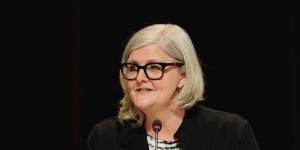
Business leader Sam Mostyn says there needs to be a major change to how women in work are discussed.Olive + Maeve
“Women spoke powerfully as leaders and I think women reset a conversation that has been wallowing in the shallows,” says Sam Mostyn,a company director and newly appointed head of the government’s Women’s Economic Equality Taskforce.
Her point:the participation of women in the economy has been treated for many years as a gender equity challenge but is now being addressed as an economic imperative. The summit highlighted this change not only with its agenda but with the people on the podium.
The stand-out quote from the event also emphasised the goal of increasing the participation of women in workforce and,by doing this,addressing labour shortages and expanding the economy. “I can’t help but reflect that if untapped women’s workforce participation was a massive ore deposit,we would have governments lining up to give tax concessions to get it out of the ground,” said Grattan Institute chief Danielle Wood.
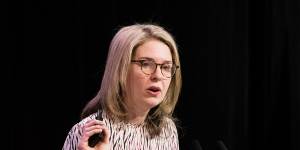
Grattan Institute chief executive Danielle Wood’s opening scene-setter for the jobs summit included pointed criticisms of long-standing policies and practices.James Brickwood
Progress,however,was slow. The event ended without a new tax concession or other incentive to help women gain access to more affordable childcare or break through a glass ceiling to earn higher salaries. The Finance Minister and Minister for Women,Katy Gallagher,had to field calls for action without being able to promise more money. The effect of the summit was to raise expectations for greater action at a later date. Albanese and Chalmers will deliver the government’s signature childcare expansion from July 1 next year but they will also have to find cash for a major change around paid parental leave.
While the headline around the increase in permanent migration was substantial,the shortage of skilled workers in the country goes much deeper.
Australian Industry Group chief executive Innes Willox remembered that in 2016 he had addressed a COAG meeting of premiers (none of those who attended this week’s summit) and then prime minister Malcolm Turnbull to warn of the then looming skills shortage.
Six years on,the shortage is now so critical there is no other single issue more important for employers.
Willox said the summit will have to deliver far more,calling for bold generational reform.
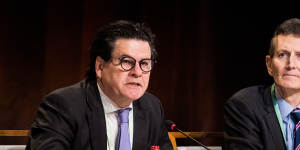
Industry group boss Innes Willox said there is no bigger issue for business than the shortage of skilled workers.James Brickwood
“A history of tepid reform has left us unprepared and wasted precious time and money. It now seems that our teenagers would rather be influencers than engineers,” he said.
That reform will need to be all encompassing.
Alan Duncan,the director of the Bankwest Curtin Economics Centre in Western Australia,said there was a long list of job market inefficiencies that went to the heart of the nation’s shortage of skilled workers.
The most noticeable is the gender split,with women’s skills not being used nearly as well as they should.
Other areas include the under-employed,the large number of over-qualified migrants whose qualifications are not or will not be recognised by Australian professional bodies,the lack of movement of people between industries,childcare and the under-use of aged pensioners and the disabled.
Duncan said while other countries such as Canada were fighting hard to bring in skilled migrants,Australia was dragging its feet.
“It’s a ferociously competitive market for skills and we have to be much better and aggressive across a range of areas to attract talent,” he said.
The summit did force those from very different policy positions into close proximity.
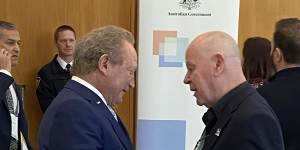
Andrew Forrest meets with CFMMEU boss Christy Cain at the jobs summit.Shane Wright
On the first day,the nation’s richest man - Andrew “Twiggy” Forrest - shared a short chat and handshake with self-professed “militant” unionist Christy Cain. The pair,who both hail from Western Australia,had previously not met.
Premiers Dominic Perrottet and Daniel Andrews had to sit side-by-side for the entire two days,bit players on the much larger stage that is the federal parliament.
The recent and more distant past did hang over the conference.
Bob Hawke’s economic summit of 1983 - held soon after his election victory - set in train a decade of policy reform that transformed the country. John Curtin’s full employment white paper of 1945 set the policy commitment that delivered a jobless rate of less than 1 per cent through the 1950s and much of the 1960s.
Both the summit and the paper proved pivotal economic turning points for Australia.
The sense of another turning point was evident in the summit’s opening address by Danielle Wood.
She did not hold her punches about the problems that have bedevilled the Australian economy since the global financial crisis.
Failures on productivity,on skills,on the use of the working population had all contributed to the stagnation in wages that has run smack bang into the sharpest increase in inflation since the turn of the century.

Wood channelled John Howard as she targeted the lack of competition across the Australian business sector,saying it was contributing to an economy was “increasingly older,fatter,and slower”.
“While being relaxed and comfortable may be profitable,it is not good for Australia’s long-term economic prospects,” she said.
With business leaders including Qantas’ chief Alan Joyce,Visy Industries chairman Anthony Pratt and Woolworths boss Brad Banducci among the crowd,it was a pointed remark.
At least they were there.
Sitting distant from the proceedings was Liberal leader Peter Dutton who had decided the “talkfest” was not worth the opposition’s time.
On hearing of the decision to lift the permanent migration number,Dutton – who as Home Affairs minister oversaw the reduction to 160,000 that contributed to the current skills shortage – said it was clear the “number needs to be higher”.
Nationals leader David Littleproud did sit through the summit. On its second day,he offered policy ideas around fee-free university placements for nurses and pharmacists who after university headed to a regional area to work.
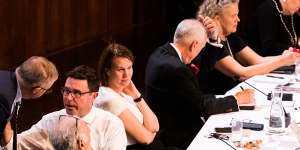
Nationals leader David Littleproud talks to Anthony Albanese during the summit.James Brickwood
For Anthony Albanese,the split in the Coalition was just the political bonus from an event that could have broken down early and publicly if some of his attendees had decided to make a very loud statement.
On the policy front,the summit gives the new government cover to sharply change the migration program of the nation. The reliance on temporary workers,the ones who were and have yet to come back,may be transformed by some of the principles agreed upon.
Since 2010,elements of Labor (and the Coalition) railed against immigration and the concept of Big Australia. Albanese used the summit to change that conversation to one of families and mortgages and “common sense”.
“It makes no sense to bring people in,have them for a few years,then get a new cohort in to adapt to the Australian work environment,” he said.
“We want people to be able to put down those roots,to have a mortgage,to raise a family,to join the Australian family migration[that] is part of our story.”
As the summit wrapped up,Treasurer Jim Chalmers said there were 36 “concrete outcomes” from the two days of talks. They included extra spending on affordable housing,likely to be supplemented by superannuation fund support,and changes to aged pension rules to encourage more people to work.
“This is,I think,the beginning of a new era of cooperation and consensus,and our task now is to take this moment,take this momentum,and to build something bigger on it,to build change that lasts,” he said.
Hawke and Curtin did mark new beginnings. But it took years for that to become clear.
It may take just as long to determine if the jobs and skills summit of 2022 can be mentioned in the same breath.
Cut through the noise of federal politics with news,views and expert analysis from Jacqueline Maley..